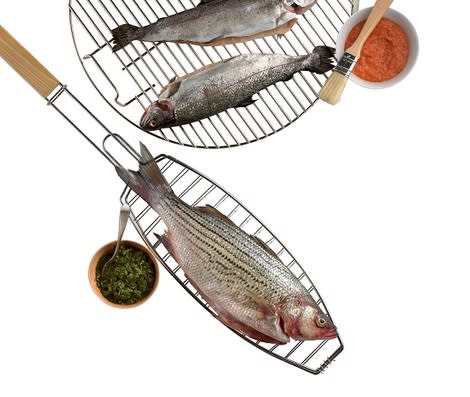4 Surprising Things You Didn’t Know About Your Fish

How much do you know about that glassy-eyed swimmer staring back at you from its grocery store bed of ice? Well, it's white, it's dead, and it's about to be dinner. But would you even know what type it is without looking at its "Hi, my name is Alaska pollock" nametag?
The truth is, most of us know nothing about the fish we buy. And that's not all our fault: Even if we did know a thing or two about Alaska pollock, it might just be a fraudster fish, according to a new report by Oceana.
PLUS: Not all fish are healthy. Here are 12 Fish You Should Never, Ever Eat
Oceana, an ocean conservancy group, has been studying seafood fraud for years. One of their recent studies found that 55% of fish from sushi restaurants in California were mislabeled as the wrong species, substituted with a cheaper type. (Every "snapper" claim tested was found to be fraudulent.) And across the nation, they found that one-third of seafood is mislabeled. Why? For starters, there's real economic incentive for committing fish fraud.
Consumers pay high prices for fake fish, says the latest report. When a fish you think you're getting is substituted for a cheaper one at a grocery store, you get gouged an average of $4. At restaurants, the damage is costlier: For the "grouper" catch of the day-too often, it's the cheaper tilapia-people sometimes pay an extra $10.
"There's no control over our seafood supply," says report author Margot Stiles, senior scientist and campaign manager for Oceana. "In terms of how bad it is for seafood, I don't think people have any idea."
Check out the 5 grossest lessons we learned from the Oceana report:
1. Seafood is seriously under-regulated. Try tracking a fish from boat to plate, and you'll find it's darn near impossible. Unlike other foods, seafood gets a free pass in the traceability department, so fraud runs rampant. One of the only laws in place is a Country of Origin Labeling law (COOL), requiring the fish's home country to be printed on the label. But it only applies to raw, unadorned fish. "Mostly people buy a filet that's already seasoned, and/or cooked and packaged," Stiles says. "That's exempt from this law."
2. Wild isn't always wild. Farmed Atlantic salmon is often substituted for wild salmon at restaurants and grocery stores. That's beyond troubling, since farmed salmon has three times the saturated fat as wild. Wild is totally worth a price premium, but only if you're getting what you pay for. Otherwise-and this happens a lot, the report found-consumers are paying $5 more for farmed salmon masquerading as wild.
PLUS: Find out which is really healthier, in our Health Food Face-Off: Wild Salmon Vs. Farmed Salmon
3. Fresh is a myth. Think that premium cut is fresh off the boat? Fat chance. "It could be a week old, a month old, or if you live close to the coast and you luckily picked the right one, a few days old," says Stiles. It's only same-day if you pulled it out of the water yourself, she said. And there's really no upper-limit to fresh fish shelf life, thanks to cold storage technologies and the freeze/thaw/re-freeze cycle. Fresh catch our fannies.
TRY NOW: These 25 Delicious Detox Dishes make eating clean easy.
4. …And frozen's sometimes healthier. Considering the behind-the-scenes life of fresh fish, why not buy frozen? Stiles says it's a good idea-and way cheaper. "You should only buy expensive fish when you're getting something that's worth more," she says.
PLUS: Which packaged goods aren't packed with preservatives? Find out the 100 Cleanest Packaged Foods.
Finally, you're not totally powerless. What can you do? Stiles had a few tips:
•Become a fishmarket pro. Know what's in season and what's local. Find a purveyor you trust and ask for the fish's species, where it was caught, and how it was caught. The more information, the better.
•Look for the whole fish, not a pre-packaged, pre-seasoned fish. That way, you're guaranteed a country-of-origin label.
•Choose traceable fish. Some companies spill the details about their packaged fish on their labels, even though it's not required by law. Seek out (and support) those fish demystifiers.
•Don't shop the sale rack. "If it looks like you're getting a great deal, I would probably suspect that there's some sort of fraud going on," Stiles says. Know your fish's market price, and buy accordingly.
Written by Mandy Oaklander
More from Prevention:
8 Foods That Pack Disease-Fighting Power
5 Foods You Should Always Buy Organic
